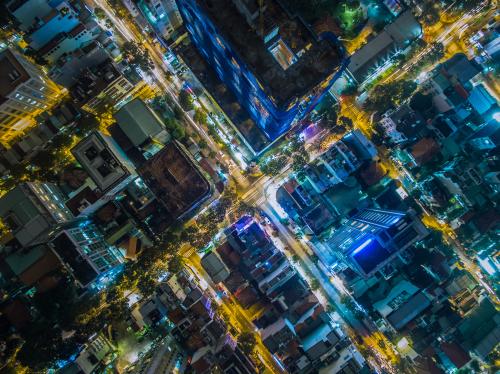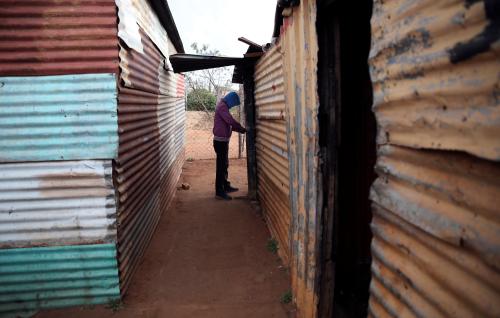This blog highlights some key insights from the authors’ chapter in the recent report, “Beyond neoliberalism: Insights from emerging markets.”
The Occupy Wall Street movement in the U.S. and the Yellow Vest protests in France capture a common feeling of discontent: The gap between the haves and the have-nots is growing.
Yet, over the last 25 years, total global inequality (inequality across all individuals in the world) declined for the first time since the Industrial Revolution (see Figure 1). This reduction was driven by falling between-country inequality, as poor countries became richer.
In contrast, progress on within-country inequality has been mixed (see Figure 2). While 50 countries saw within-country inequality decline between 2000 and 2015, 34 countries experienced an increase, notably some advanced economies where the poor and middle class have seen stagnant income growth.
The data have a few caveats. First, the data do not capture what has happened at the upper end of the distribution. When we include the incomes of the top 1 percent, the rise in within-country inequality becomes much starker. Second, the fact that global inequality is falling stands at odds with people’s perceptions. The average person in many countries, echoing the sentiments of the Occupy and Yellow Vest protestors, thinks that inequality is higher than it is; and that it has increased.
Increased inequality is one source of discontent with the neoliberal model. Also contributing to the discontent is a sense that the system is “unfair.” According to a recent survey in Europe and Central Asia, 20 percent of people believe that good connections are the primary driver of upward mobility. This contributes to the perception that wealth and opportunity are concentrated among a few who “luck out” based on circumstances of birth.
Drivers of inequality
How can we explain the sharp rise in within-country inequality where it has occurred? The current debate points toward a range of factors, including the persistence of deep inequalities of opportunity in the accumulation of human capital, the role of superstar firms with market power, and the impact of technological change. Another set of drivers are institutional, notably the decline of unions that gave workers a voice, and the negative impact of globalization on the ability (or willingness) of governments to tax corporate profits to support social safety nets.
Policies to help reduce inequality
In order to tackle rising inequality, we need to invest in policies to make market-driven growth more pro-poor and inclusive. First, we must reduce inequality of opportunity and its intergenerational transmission. Second, we need new policies to correct the failure of the labor market to provide decent employment and earning opportunities to a growing swath of the workforce in many countries. Third, we need progressive taxation and spending, but as a complement to—not a substitute for—policies that address the two core drivers of inequality.
In practice, this means:
- Policies to develop the human and physical assets of the bottom 40 percent. One example: Early Childhood Development policies to promote physical, socio-emotional, and cognitive development in the early years. Children in poor households need this the most but get it the least.
- Policies to ensure that markets work fairly for everyone. This means reducing market power concentration and rent-seeking behavior among firms. In some countries, this may mean less business regulation in order to foster a more business-friendly environment. In others, it may mean the opposite.
- Policies to “build a strong and resilient middle class.” In order to protect workers and the existing or emerging middle class from shocks, social protection programs must adapt to the changing nature of employment relationships—in effect, de-linking social benefits from employment contracts. This is especially important in countries with large informal sectors.
- Development of effective training programs. The demand for skills is changing, yet existing training programs are ill-equipped to reskill older workers. Emerging evidence suggests that experiential, on-the-job training is more effective than classroom instruction. More flexible options for post-secondary schooling are also needed, allowing for greater movement between the labor market and school.
- Mobility policies and support for lagging regions. Large spatial disparities in labor market opportunities exist in many countries. Policies such as targeted college scholarships, housing credits, and portable social benefits can help facilitate movement to more productive areas. Some economists have also argued for renewed place-based policies to support opportunities in lagging regions.
- Expansion of progressive transfers. In more formalized settings, in-work, earned-income tax credits or graduated social assistance can be combined with activation measures to support re-employment. In developing countries, transfers need to fit the local context: Worker tax credits are feasible in some settings, while unconditional or conditional cash transfers may be better in others.
- More effective use of tax policy. Governments will need to raise additional revenue in order to finance a more progressive social safety net. There is room to both broaden the tax base while reducing exemptions that favor top earners. Corporate income taxes represent a potentially large source of revenue, but international cooperation is required to combat tax evasion and capital flight. Taxes on environmental externalities could also help fund social safety nets.
It’s time to reframe the narrative on inequality. Overall, trends are not as dire as the global rhetoric contends; total global inequality has declined and within-country inequality has fallen more often than it has risen. The countries that experienced a decline did so largely by adopting some combination of the above policies; Latin America, for instance, heavily invested in education to reduce inequality of opportunity.
However, progress is not inevitable. Promoting inclusive, pro-poor growth requires concerted policy efforts. Real structural inequalities in the economy prevent the poor from rising to the middle class and leave the middle class vulnerable to shocks. The growing populist movement in advanced economies is a predictable response to stagnating wages, middle class contraction, and worker displacement. Yet populist policies are likely to make the problem worse in the long run. In order to combat this growing discontent, governments need to play an active role, tackling pre-distribution, in-distribution, and post-distribution inequality.









Commentary
Is inequality really on the rise?
May 28, 2019